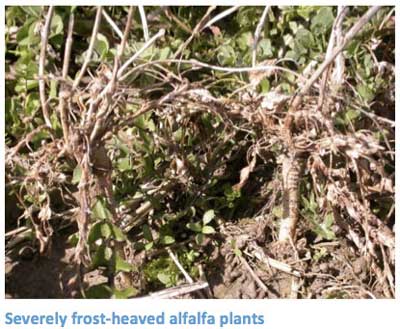
A number of cultural and management factors can influence alfalfa’s susceptibility to winter weather injury. Older stands, varieties that lack superior winter-hardiness or disease resistance, low soil pH, low soil fertility (particularly potassium), fall cutting between September 1 and October 15, all can increase the likelihood of winter injury. These stresses are additive, so the more stresses a field has endured the greater the chances of winter injury. This year, late seasonal cutting in 2013 could be especially important because of the corresponding lack of stubble that could trap snow.
Weather conditions that increase the chances for winter injury (including frost heaving) are primarily bitter cold with no snow cover, ice sheeting, and wide temperature fluctuations. Injury can be as obvious as dead plants and reduced stands or, perhaps less noticeable, as low tonnage or reduced forage quality. An alfalfa field that is slow to green up this spring should be examined closely for signs of winter injury. Be sure to allow extra time for alfalfa stands to green up this year because of deep frost penetration into the soil and general delays in arrival of warm weather.
Dennis Cosgrove and Dan Undersander, forage specialists with the University of Wisconsin, developed the following guidelines for diagnosing winter injury and managing damaged stands. We have added to the guidelines. Look for the following symptoms:
FROST HEAVING – Frost heaving has been severe in many areas in recent years. Frost heaving is elevation of the alfalfa crown above the soil surface. This occurs when frequent freezing and thawing of soils cause soil expansion and contraction that squeezes the alfalfa taproot, forcing it upward in the soil. This will often result in breakage of lateral roots. This type of damage is especially common on fine textured, water saturated soils.
ASYMMETRICAL GROWTH – Buds for spring growth were formed last fall. If parts of an alfalfa root have been killed, only the living portion of the crown will give rise to new shoots.
UNEVEN GREENUP AND GROWTH – If some buds on the crown have been injured while others have not, the uninjured buds will start growth early while the killed buds must be replaced with new buds before growth can begin.
ROOT DAMAGE – Plants should be dug up 4 to 6 inches deep and then split lengthwise with a knife. Winter killed roots will have a gray, water-soaked appearance just after the soil thaws. Once water leaves the root, the tissue will turn brown, dehydrated and stringy. If the root is soft and water can easily be squeezed from it, or is brown, stringy and dehydrated it is most likely winter killed. Also, if 50% or more of the rot is blackened from root rot, the plant will most likely die during spring green up or later in the year. A healthy root should be firm and white with little evidence of root rot.